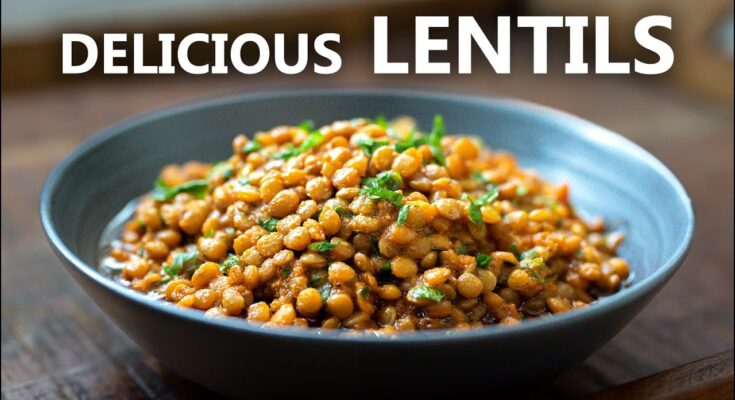Lentil Recipe: Lentils might just be one of the most underrated ingredients in your pantry. These tiny legumes pack a serious punch when it comes to nutrition, taste, and versatility. Whether you’re whipping up a hearty soup, a spicy curry, or a refreshing salad, lentils adapt beautifully to any dish.
Plus, they’re budget-friendly and super easy to cook! If you’ve ever been intimidated by the idea of cooking lentils from scratch, fear not. This step-by-step guide will make you a lentil master in no time.
Health Benefits of Lentils
Not only are lentils delicious, but they’re also a powerhouse of nutrition. Rich in protein, fiber, iron, and folate, lentils support heart health, stabilize blood sugar levels, and keep you feeling full longer. They’re especially great for vegetarians and vegans who are looking for a plant-based protein source. Eating lentils regularly can also contribute to better digestion, thanks to their high fiber content. Seriously, it’s like giving your body a big, warm hug every time you add lentils to your plate!
Types of Lentils You Can Use
Lentils come in different colors and varieties, each offering a slightly different flavor and texture. Here’s a quick overview:
Red Lentils
These cook up quickly and have a soft, mushy texture, making them perfect for soups and purees. They have a slightly sweet, nutty flavor that pairs well with strong spices.
Green Lentils
Firm and peppery, green lentils hold their shape well after cooking. They’re excellent for salads and side dishes where you want a bit more bite.
Brown Lentils
The most common type found in stores, brown lentils are your all-purpose lentil. They have an earthy flavor and work beautifully in stews and casseroles.
Black Lentils
Also called beluga lentils, these tiny, shiny lentils resemble caviar. They’re rich in flavor and make an elegant addition to salads and gourmet dishes.
Ingredients Needed for a Simple Lentil Recipe
Before diving into the cooking process, make sure you have everything you need. Here’s a basic list:
- 1 cup of dry lentils (any variety)
- 3 cups of water or broth
- 1 small onion, diced
- 2 cloves of garlic, minced
- 1 bay leaf
- 1 teaspoon of salt
- ½ teaspoon of pepper
- Optional add-ins: diced carrots, celery, cumin, turmeric, thyme, or any herbs you like
Gathering your ingredients beforehand ensures a smooth cooking process. Trust me, you don’t want to be scrambling for spices while your lentils are already simmering!
Step-by-Step Guide to Cooking Lentils
Now, let’s roll up our sleeves and get cooking!
Step 1: Rinse the Lentils
First things first: always rinse your lentils under cold running water. Place them in a sieve or strainer and give them a good rinse to remove any dust or debris. You might even find a tiny pebble or two — better safe than sorry!
Step 2: Soak (Optional but Recommended)
While not necessary, soaking lentils for about 1-2 hours can speed up the cooking process and make them even easier to digest. If you’re short on time, you can skip this step. But if you have a little extra time, soaking is a small effort with big rewards.
Step 3: Prepare the Cooking Liquid
Pour your water or broth into a pot. Using broth instead of water adds an extra depth of flavor, but water works just fine if you plan to season heavily. Add your diced onion, garlic, bay leaf, and any other aromatics to the pot at this stage. Bring it to a gentle boil.
Step 4: Simmer the Lentils
Once your liquid is boiling, add the rinsed (and soaked, if applicable) lentils. Reduce the heat to a low simmer and cover the pot loosely. Cooking time will depend on the type of lentil:
- Red Lentils: 15–20 minutes
- Green Lentils: 25–30 minutes
- Brown Lentils: 20–25 minutes
- Black Lentils: 25–30 minutes
Keep an eye on them and give a gentle stir occasionally. You want them tender but not mushy — unless you’re making a puree, in which case, cook away!
Step 5: Season to Taste
Add salt towards the end of cooking, not at the beginning. Salting too early can make the lentils tough. Once your lentils are tender, season with salt, pepper, and any other spices or herbs you like. Taste and adjust as needed.
Tips for Perfect Lentils Every Time
Even though lentils are pretty forgiving, a few tips can make your cooking game even stronger:
- Watch the water level: Lentils absorb a lot of water, so keep an eye on the pot. Add more liquid if necessary.
- Don’t overcook: Unless you want a mushy texture, keep checking them toward the end of cooking. They should be tender but still hold their shape.
- Add acid last: Ingredients like vinegar, lemon juice, or tomatoes can toughen lentils if added too early. Stir them in after the lentils are fully cooked.
- Flavorful additions: Toss in spices like cumin, coriander, turmeric, or bay leaves early in the cooking process to infuse your lentils with deep, rich flavors.
Cooking lentils perfectly is an art that anyone can master. A little patience and attention go a long way!
Delicious Variations to Try
Feeling adventurous? Here are some fun variations to take your lentils from basic to mind-blowing:
- Spicy Indian Lentils: Add a mix of turmeric, cumin, coriander, and a splash of coconut milk. Garnish with fresh cilantro.
- French Lentil Salad: Use green lentils, toss with vinaigrette, diced shallots, and parsley for a refreshing, protein-packed salad.
- Smoky Lentil Soup: Add smoked paprika, diced carrots, celery, and a handful of spinach at the end for a hearty, warming soup.
- Lentil Tacos: Season cooked lentils with taco spices and use them as a healthy filling for your tacos.
Lentils are like a blank canvas — they soak up flavors and spices effortlessly, making them ideal for endless culinary creativity.
What to Serve with Cooked Lentils
Lentils are versatile enough to be a main dish or a sidekick to your favorite meals. Here are some ideas:
- With rice: Classic and comforting — especially with a sprinkle of crispy onions on top.
- As a salad base: Top a bed of lentils with grilled chicken, feta, and fresh veggies for a nutrient-packed meal.
- Alongside roasted veggies: Earthy lentils pair beautifully with roasted carrots, squash, and beets.
- Stuffed in wraps or pita bread: Add a dollop of hummus and some crunchy greens for a quick lunch.
- Next to grilled meats: Lentils’ hearty texture complements grilled lamb, chicken, or beef beautifully.
The humble lentil easily becomes the star or the best supporting actor of any meal you craft.
How to Store and Reheat Lentils
Cooked lentils store and reheat wonderfully, making them perfect for meal prep!
- In the fridge: Store cooked lentils in an airtight container for up to 5 days. They’ll stay flavorful and ready for quick meals.
- In the freezer: Lentils freeze well for up to 3 months. Cool completely before transferring them to a freezer-safe bag or container. Thaw overnight in the fridge before reheating.
- To reheat: Add a splash of water or broth when reheating lentils on the stovetop or microwave to keep them moist and delicious.
Having lentils ready to go is like having a secret weapon in your fridge — perfect for those busy days when you just need something fast, filling, and healthy.
FAQs about Lentil Recipe
1. What is the best type of lentil to use?
It depends on your recipe! Green and brown lentils hold their shape well, making them perfect for salads and side dishes. Red and yellow lentils cook faster and are great for soups and stews.
2. Do I need to soak lentils before cooking?
No soaking is necessary for most lentils. Simply rinse them under cold water to remove any debris and start cooking. Soaking is optional but can help reduce cooking time.
3. How long do lentils take to cook?
Lentils usually cook within 15 to 30 minutes, depending on the variety. Red lentils cook the fastest, while green and brown lentils take a little longer.
4. Can I freeze cooked lentils?
Yes! Cooked lentils freeze very well. Store them in an airtight container for up to three months. They’re perfect for quick meals later.
5. Why are my lentils mushy?
Overcooking or using too much water can cause lentils to become mushy. Always follow the recipe’s cooking time and test for doneness earlier to keep them firm if needed.
6. Are lentils healthy?
Absolutely! Lentils are packed with protein, fiber, iron, and other essential nutrients, making them a powerhouse for plant-based and healthy diets.
7. What can I add to lentils for more flavor?
Season your lentils with onions, garlic, herbs, spices, and broth instead of just water. A splash of lemon juice at the end can also brighten the flavors beautifully.
Conclusion
There you have it — a complete, step-by-step guide to mastering lentils! Whether you’re brand new to cooking or a seasoned home chef looking to add more plant-based meals to your repertoire, lentils are an excellent go-to. They’re affordable, nutritious, delicious, and insanely versatile. Plus, once you nail the basic technique, you’ll find endless ways to jazz them up with spices, herbs, and sauces.
So next time you’re standing in the grocery store wondering what to cook for dinner, grab a bag of lentils. Your future self (and your taste buds) will thank you!



